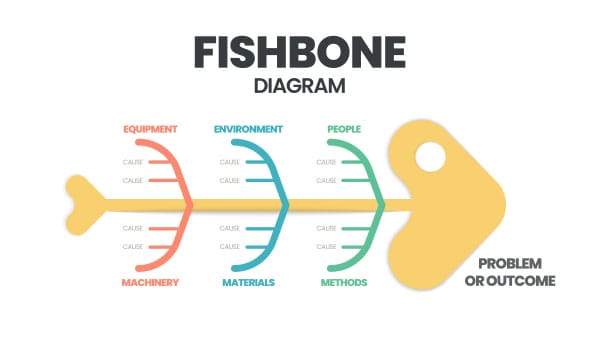When something goes wrong in your business, simply bandaging the issue is not a smart decision. Successful businesses will find and resolve the root cause of the problem. That will mean never having to revisit that issue again. This saves time, energy, and resources. Focusing on root cause analysis (RCA) as a way of understanding problems leads to finding the right solutions.
Why Invest in Root Cause Analysis Training?
Root cause analysis training is important so not only you but also your team members engage in problem-solving. By sending key team members to training, they too will learn to recognize, resolve, and implement techniques to prevent problems in their specific department. You’ll be empowering your employees and giving them problem-solving skills to analyze and find the root cause of some of the toughest issues facing your organization.
8 Steps of the Root Cause Analysis Training Process
The root cause analysis process generally has eight steps:
Step 1: Identify the problem
Here the problem is identified, be it a nonconforming product or a process that isn’t working right.
Step 2: Identify the team
A team is compiled to address the problem. Ensuring team members are in the right roles to put their new skills into action is important to help fix the issue.
Step 3: Containment
If non-conformance (NC) is discovered, it is critical to take the necessary steps to resolve the situation. From determining if the NC requires the filing of a corrective action report to using a team approach to review, contain, and correct the product’s non-conformance, this is one step that is often urgent.
Step 4: Problem Description
The team approach is very helpful in this step of the problem-solving process to brainstorm the possible causes to eventually help identify the root cause. A variety of strategies including Cause and Effect Diagrams, “Pareto”, 5 Why’s, and Is and Is Not can be used to analyze initial root causes. If it is determined that the cause is company-wide and thus outside the team’s control to resolve, it needs to be elevated to upper management.
Step 5: Identify possible causes
The team approach is also very helpful in this step of the problem-solving process. The more input as to possible causes, the more likely you will identify the root cause. What-If is one of the tools that work well to analyze initial root causes. Using a Fishbone Analysis can help verify the possible causes of a problem and subsequently find the root cause. This process is outlined in the tools and techniques section below. Root causes can be tricky. Determining an incorrect root cause will result in failure to solve the real problem.
Step 6: Identify root cause
The skills required to complete this step of the course often depend on the experience of the team members. Applying various tools and techniques as described below are also beneficial in this problem-solving step. Finding the most effective solution to the problem may involve reviewing historical data, development of new processes, or analyzing new concepts.

Step 7: Determine and Implement Corrective and Preventive Actions (CAPA)
Up until this step, all of the work in this training course has been in researching, analyzing, and determining a solution. The result of this problem-solving step is a list of actionable steps for your organization to take that will correct and solve the problem, and another list of preventative action steps to prevent its reoccurrence.
Finally, the results of your training is actually implemented in this step. The work to flush out the problem, create the right teams, search for and then define root causes, create possible solutions and learn skills needed to pinpoint the best one, and develop the action steps to correct and prevent the problem are all behind you. It’s time to meet the main objectives of the course and put all that learning into action. It’s time to do!
Step 8: Test to validate effectiveness
Testing to ensure the problem does not reoccur after its solution has been implemented is necessary and can be reason to give you and your team a pat on the back for a job well done. Or not.
If the problem reoccurs, it can mean a number of things:
- The problem was only partially fixed
- The method of monitoring or measuring the results was flawed
- The root causes were not correctly identified resulting in failure to solve the real problem.
At this point, some of the steps above need to be repeated to find errors in the process or zero in on the real root cause.
Tools and Techniques Used in Root Cause Analysis Training
Several tools and techniques may be used in an RCA training course.
FMEA (Failure Mode and Effect Analysis)
Failure Modes and Effects Analysis (FMEA) is a systematic, proactive method for evaluating a process to determine where and how it might fail. It also assesses the relative impact of different failures in order to find the parts of the process that are most in need of change.
The FMEA Systematic Approach
- Steps in the FMEA Process
- Failure modes (What could go wrong?)
- Failure causes (Why would the failure happen?)
- Failure effects (What would be the consequences of each failure?)
Fishbone Analysis

A cause and effect diagram–often called a “fishbone” diagram–can help in brainstorming the possible causes of a problem and in sorting ideas into useful categories. A fishbone diagram is a visual way to look at cause and effect. It is a more structured approach than some other tools available for brainstorming the causes of a problem (for example, the Five Whys tool).
The problem or effect is displayed at the head or mouth of the fish. Possible contributing causes are listed on the smaller “bones” under various cause categories. A fishbone diagram can be helpful in identifying possible causes for a problem that might not otherwise be considered. It directs the team to look at the categories and think of alternative causes. Include team members who have personal knowledge of the processes and systems involved in the problem or event to be investigated.
What-If
What-IF is also called an Ishikawa Diagram. This tool helps when brainstorming the analysis process and trying to identify items that may have caused a problem. It is a root cause tree in reverse. A tree works to narrow down the causes and a fishbone widens the list.
HAZOP (Hazard and Operability Study)
A structured and systematic technique for system examination and risk management. In particular, HAZOP is often used as a technique for identifying potential hazards in a system and identifying operability problems most likely to lead to nonconforming products.
Fault Tree Analysis
Fault tree analysis is a graphical tool used to explore the causes of system-level failures. It uses boolean logic to combine a series of lower-level events and it is basically a top-down approach to define the component level failures (basic event) that cause the system level failure (top event) to occur.
MORT (Management Oversight and Risk Tree)
In MORT analysis, most of the effort is directed at identifying problems in the control of a work/process and deficiencies in the protective barriers associated with it. These problems are then analyzed for their origins in planning, design, policy, and so on.
To use MORT, one must first identify key episodes in the sequence of events. Each episode can be characterized as:
- a vulnerable target exposed to – or
- an agent of harm in –
the absence of adequate barriers.
MORT analysis can be applied to any one or more of the episodes identified; it is a choice for you to make in the light of the circumstances particular to your investigation. To pinpoint these key episodes, you will need to undertake a barrier analysis (or “Energy Trace and Barrier Analysis” to give it its full title). Barrier analysis allows MORT analysis to be focused; it is very difficult to use MORT, even in a superficial way, without it.
Root Cause Analysis and Six Sigma Certificate
 To obtain a Six Sigma certificate requires–among many other courses–satisfactory completion of a root cause analysis training course. The class can be either in person or online. However, always check with your Six Sigma program coordinator to validate that the course you wish to take will be accepted by your program. There are different requirements depending on the program, and not all RCA courses qualify.
To obtain a Six Sigma certificate requires–among many other courses–satisfactory completion of a root cause analysis training course. The class can be either in person or online. However, always check with your Six Sigma program coordinator to validate that the course you wish to take will be accepted by your program. There are different requirements depending on the program, and not all RCA courses qualify.
Successful Root Cause Analysis Online Training
If you are considering taking an RCA course online it helps to find the right class for your learning style. Some questions to consider to decide what you’d like to get out of a class.

- Is the course interactive or is it solo with no other participants?
- Is there a live instructor for the course?
- Does the course include exercises related to effectively find a solution to the types of problems I see in my job?
- Do the methods and concepts that are used to find a solution fit my organization’s type, such as manufacturing or service?
- Is the course held during hours I can easily attend given my work schedule?
- How much experience does the instructor possess?
- Will the skills that I learn and the certificate I receive make me more valuable at my job?
- Does the company offer other courses that coordinate with my needs?
The EMDS Course on Corrective Action/Root Cause Analysis
The Corrective Action/Root Cause Analysis course by EMDS is one of several courses we offer in the safety and compliance field. Our online course is held in a virtual classroom with a live (and lively) instructor. It runs for 4 hours, usually in the morning. You’ll receive a certificate of completion and a world of knowledge to help support your company and its future success.

